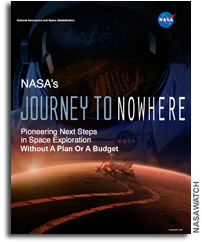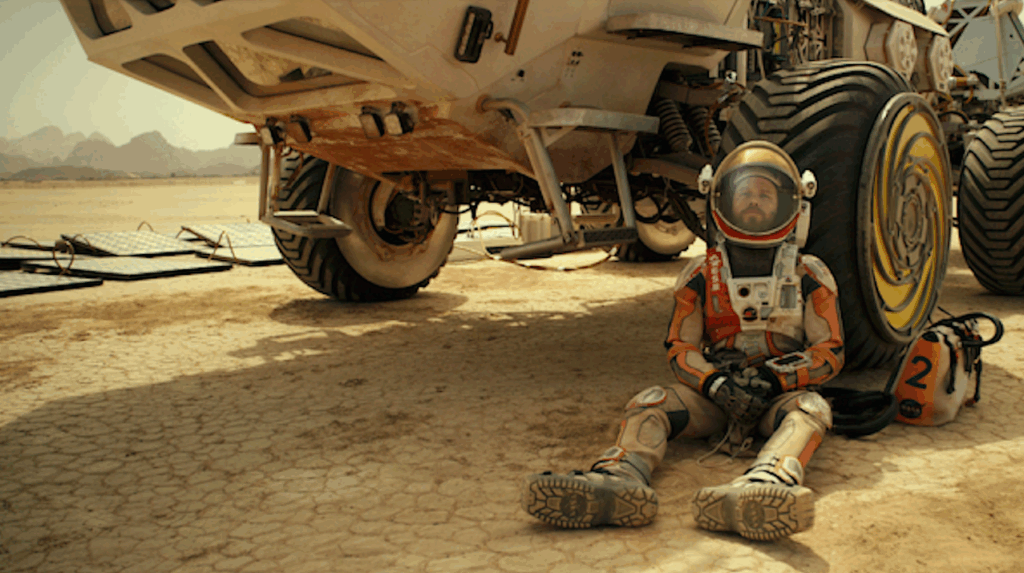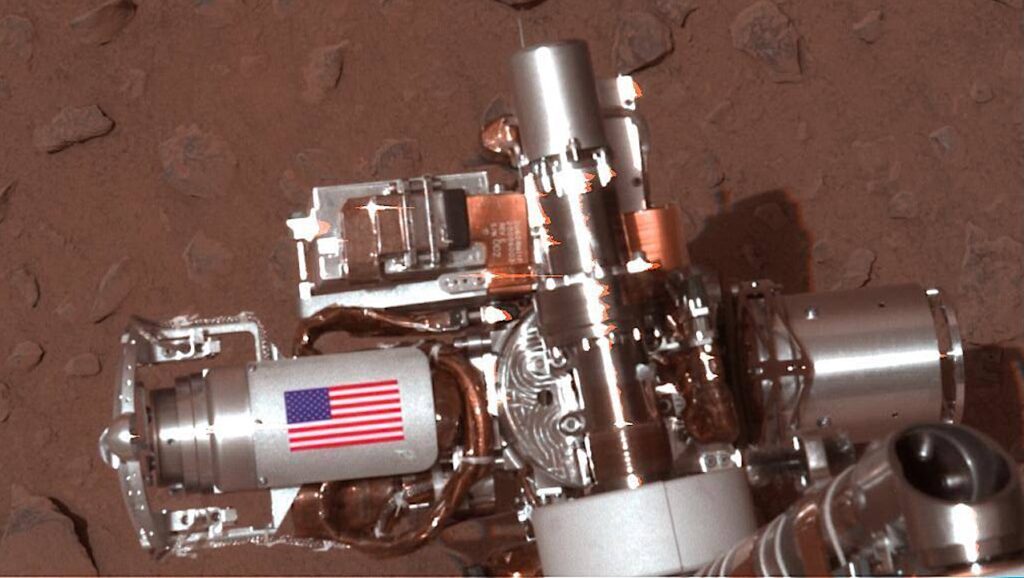NASA Just Confirmed That Their Whole #JourneyToMars Thing Is Broken

NASA realizes SLS and Orion are too expensive, opens door to competitors, Ars Technica
“Specifically, the document requests responses about: “Competing exploration services in the mid-2020s timeframe and beyond if the market demonstrates such services are available, reliable, and consistent with NASA architectural needs.” Ars understands this to mean that if private competitors such as SpaceX, Blue Origin, United Launch Alliance, or other companies produce less expensive rockets and spacecraft within the next five to seven years, NASA will consider using them in lieu of SLS and Orion.”
NASA OIG Reiterates Issues With SLS/Orion
“… Program officials are working toward an optimistic internal launch date of August 2021 for EM-2 – 20 months earlier than the Agency’s external commitment date of April 2023. While we understand the desire to meet a more aggressive schedule, this approach has led the Program to defer addressing some technical tasks to later in the development cycle, which in turn could negatively affect cost, schedule, and safety.”
 Keith’s note: What is odd about this SLS RFI and the earlier one concerning Orion is the timing. NASA is releasing them at the very end of the Obama Administration – days after an election that will result in a certain amount of tumult – at a time when White House and NASA senior staff are either gone, leaving, or on travel so as to avoid being in their office. Usually NASA does document drops in this way in the hope that no one will notice. Add in the fact that the due date is just 2 days before Christmas and that responders will need to work over Thanksgiving Day weekend. Do you really think NASA is at all that serious about getting the best possible responses?
Keith’s note: What is odd about this SLS RFI and the earlier one concerning Orion is the timing. NASA is releasing them at the very end of the Obama Administration – days after an election that will result in a certain amount of tumult – at a time when White House and NASA senior staff are either gone, leaving, or on travel so as to avoid being in their office. Usually NASA does document drops in this way in the hope that no one will notice. Add in the fact that the due date is just 2 days before Christmas and that responders will need to work over Thanksgiving Day weekend. Do you really think NASA is at all that serious about getting the best possible responses?
Is NASA trying to squeeze its contractors ahead of a new administration that may pivot more toward private sector solutions? Is NASA trying to curry favor with a new administration in the hope that they will get budgetary relief to fix their problems? Or is NASA just plain embarrassed that they have to admit the obvious? There seems to be a pattern emerging. Just the other day Greg Williams from NASA HQ told a NASA Advisory Council subcommittee that NASA did not know what it would actually cost to send humans to Mars because they had only worked out the costs up to a cis-lunar mission. Seven years and NASA does not know how much #JourneyToMars will actually cost? Really?
These RFIs could have easily been issued several years ago since they ask for commercial alternatives to SLS/Orion. Indeed, if anyone at NASA had bothered to read the Commercial Space Act of 1998, Title II – P.L. 105-303 (this is posted on NASA.gov) – specifically Title II (a) – they’d see that they should have been seeking commercial alternatives all along: “Except as otherwise provided in this section, the Federal Government shall acquire space transportation services from United States commercial providers whenever such services are required in the course of its activities. To the maximum extent practicable, the Federal Government shall plan missions to accommodate the space transportation services capabilities of United States commercial providers.”
Only now, after 7 years of delays, cost overruns, an inexplicably absent mission architecture, and false advertising via social media, does NASA admit that it may need to rethink how it is going to send humans to Mars. This has to be due to the fact that the whole plan (or lack thereof) is not going to work as “planned”. Otherwise, why would NASA be asking for alternate ways of doing it?
– Re-Imagining SLS and Orion
– NASA Officially Admits It Has Not Figured Out #JourneyToMars Cost
– SLS Orion posts









Well, its not really a coincidence that the cracks forming in SLS are coming a few months after the Air Force announced the program to replace the Minuteman. The SLS was at some level intended as a make work program that kept the industrial base for large solid rocket motors going in the gap between shuttle retirement and this program. SLS can finally go away now.
Air Force Kicks Off Program to Replace Minuteman III Missiles
http://www.nationaldefensem…
Unless a RESPECTED national leader makes it a national priority as JFK did with his “to the Moon speech”, and unless a congress that actually accepts science as legitimate and worthwhile agrees, we ain’t going to Mars and that is NOT NASAs fault.
China is going to own the Moon, and pwn us.
As far as I can tell at no time was science an important motive for going to the Moon. Because they were going anyway it was decided that some science could be done. I’m not aware of a serious planetary scientist who does not feel that, with the available money, robotic exploration of Mars is more practical, at least at the present, then sending a few people.
As to China, they see no value in a new Moon race. If they lost, they would look incompetent. If they won, they would irritate their biggest customer.
You’ve nailed it, Dr. There’s no reason to go to the moon. Nor Mars. And that’s the thing: all of us want the country to go to one or the other, to have permanent camps because it’s ‘the future’. But the reason nothing is happening is pretty simple: there is no compelling reason to do either.
At least that’s the case in the 21 century where commercial enterprise overshadows even the great age of mercantilism. Perhaps a century will come when other, better motivators will come to the fore. Maybe.
sure, in the purely lunar geography/geology sense, we didn’t learn anything we would not have learned cheaper and faster with a few robotic probe…maybe…
But in terms of developing technology and capacity to do great things, Apollo is STILL giving us returns. Going to the moon didn’t teach us much about the moon, but it taught us one hell of a lot about what we can do if we give a shit and make an effort. Mars will be the same if we have the guts and determination to go for it.
No worries though, the chances that we will actually pull our heads out and seriously try for Mars are slim and none.
Well, I’m a planetary scientist, and sometimes I’m serious. I’d definitely say there is good, Martian field work that can’t be done robotically. If the cost gets down to what Mr. Musk believes possible, sending a geologist would be worth it. But, at the moment, I’m not ever enthusiastic about multi-billion dollar robots. A dozen small (MER-like) rovers would probably be a more efficient scientific program.
By the way, China may not be interested in a Moon race, but they are certainly interested in going to the Moon. They simply don’t seem to care about getting there before or after the next American landing.
Exactly. Moreover they appear open to going alone, with other partners, or with the US. Their primary geopolitical goals (building national pride, developing international relationships, and marketing their commercial aerospace capabilities) can be satisfied either way.
LBJ made it the priority..
I don’t disagree. Mr. Kennedy may have announced the project and inspired the nation, but he put his VP in charge of making it happen and he probably could not have made a better choice. Mr. Johnson was a master at maneuvering the halls of congress and building broad support from both sides of the aisle.
In no small part, his efforts helped transform parts of Texas and hundreds of other regions into a technology and engineering centers that remain powerhouses to this day.
But in regard to respected national leaders capable of inspiring a national vision to achieve a great goal, there has not been one in the White House since Johnson, (by his own admission in February of 1968) lost it. Since the 60s, and certainly after 1973, neither party has been able to field a candidate capable of inspiring broad respect from the opposition party, and without such a leader, I do not believe we will EVER be able to muster the courage and determination to travel beyond low Earth orbit, let alone return to the Moon or strike out for Mars.
And I believe that to be a great shame. Manned spaceflight united our nation in a grand and noble, peaceful purpose. Regardless of the science, dollar for dollar, and life for life we received a far greater economic payback for our investment in the Moon shot than for our foray into Indochina.
Nothing can be said, just sad and disappointed. 🙁
Is that something they could really give a useful number for? A lot of the hardware for getting there doesn’t exist. It’d be just guessing.
It’s true that when NASA was asked by President Kennedy to estimate the cost of Project Apollo, they gave Administrator James Webb an estimate of $6 billion, less than a third of the actual cost. But Webb didn’t give that number to Kennedy because he knew they were bidding low to avoid “sticker shock”. Webb gave Kennedy his own estimate, $20 billion. His estimate was accurate to within a few percent, not because he had more data, but because he was unbiased. Kennedy was shocked but gave the go-ahead anyway.
The reputation NASA has for underestimating program costs is not because it isn’t possible to be accurate, it’s because an accurate estimate of the cost when a program is unusually expensive often results in the program being cancelled, whereas once a few billion has been sunk Congressional support develops and the program may survive despite cost overruns. What we need to accept in such a case is that maybe giving an accurate estimate from the start and accepting cancellation is actually the right thing to do.
Good points. I definitely think we should given an accurate estimate and then go from there, even if it means Congress balks at the program and says no. If they do, then we come up with a different program at a lower cost point, and try and tell them.
James Webb was the Administrator. Gilruth gave a price tag of $6billion. Webb doubled it to $12. VP Johnson doubled it again to $24.
Probably true in the main, but on the other hand many projects involve so many new technologies that costs cannot be estimated.
If the technology is really undefined a reasonable strategy is to propose an R&D program or a technology demonstration program so that the risk can be reduced before committing funds to a massive project.
I don’t think new technology is the problem. For a Mars mission, we aren’t talking about anything fundamentally new. It’s mostly putting together or adapting technology we already have. Take two tethered spacecraft, spinning for artificial gravity as an example. We know how to build load-bearing cables (suspension bridges). We know how to deploy long tethers from spacecraft (the antennas on IMAGE were 250 meters.) Load-bearing, in space and high reliability, that would be new. But you could look to past work on similarly large developments, add some margin, and at least estimate the cost to within a factor of two. Something fundamentally new, like a warp drive or a usable, high temperature superconductor, that would be virtually impossible to cost.
I think one real problem is that you can’t do a cost estimate for an undefined project. What, exactly, is this journey to Mars? Are we talking about landing one guy, having him do a few hours of EVA work, and leaving after a few weeks (yes, the launch windows allow that)? Or ten people spending a year there and doing serious, long-range overland traverses? Or something the size of Mr. Musk’s proposed colony? NASA’s plans aren’t exactly clear on the subject. So a cost estimate would be like asking me how much it would cost to go from Boulder to San Francisco. Is that by Greyhound or rented Lear jet?
A good sign you’re not doing a development program, but a bunch of blue-sky research programs shoe-horned into a funding path.
James Webb, not Fletcher. He came later.
Sorry,I’ll correct the OP
On the story about Webb and costs – I’ve heard it many times but not seen it documented and wonder if you had?
This may sound odd, but you can get a good idea of what something like this may cost, even far out. A VERY good idea.
You start by seeing what your current obligations are, like SLS, Orion, Space Flight Support, and other mouths to feed. Next you see what happens when an obligation ends, like ISS, commercial cargo, commercial crew, etc. You take a good hard look at what becomes “real” money, available money, not the sort that likely just sits like cured cement after ISS ends, practically speaking, unavailable for new procurements. You look at how much flying these developed systems like SLS Orion will cost for 1 flight, or 2, or 3 a year. And upgrades. And possible cost inflation over time.
How much will the mission X Cost? It’s what’s left over in a budget scenario where nominally the budget is what it was before, growing at a rate like it grew before. If the number is negative, after some basic nominal uncertainties, or some ridiculous low amount per year, you can afford zero missions to X.
If the number is ample per year, after uncertainties, inflation, loss of purchase power, flying the systems you already know, etc. then you can start to divide the amount, this much per year for a hab, for a lander, for more Habs, for more people, etc.
You can guess the situation now.
(With a caveat, we can estimate costs well now, we just don’t know what we’ll get for the cost.)
Isn’t that saying it will cost as much per year as Congress will fund, and to get the total cost, multiply be the time Congress will continue to fund it? I’m not saying you are wrong, since I can think of projects whose budget ended up being like that. But I don’t think that’s a good tradition to follow.
I only put it this way to say there are budget realities that should inform how a project is managed, designed, and approached. When a project ignores budget realities, saying the cost estimated is X, with a hard headed my way or the hiway attitude, knowing there is little chance of ever getting that budget, something is wrong.
This is especially so when I see any study or process of trying to fit into a budget shut down, denial, politics and all. Then when the project is canceled, or when the project is merely a shadow of its public promises, the stakeholders feel offended, that they did nothing wrong. And with the whole my way or the hi way attitude, they move on to their next unaffordable, unsustainable project.
Given China’s advances in spaceflight, if our relationship with Russia goes further south our astronauts may be able to ride with the Chinese in the future.
Explain why they would not ride the TWO american commercial crew service providers coming online?
China launches astronauts once every two to three YEARS how does that help us?
Because to do that would mean abandoning the International Space Station since the commercial crew service seems to be on the same schedule as NASA’s next manned mission……as in who knows!
Seems like everyone knows.. but you.
Because to do that would mean abandoning the International Space Station since the commercial crew service seems to be on the same schedule as NASA’s next manned mission……as in who knows!!!!
It is worth pointing out that the commercial crew services have no place to go other than ISS.
Out space program has ‘bootstrap’ written all over it. There is nowhere in sight a destination for commercial crew except that provided by NASA/ ISS.
Bigelow has stated AND already committed the capital for a destination once there is domestic commercial transportation services.. so yes there is a place to go besides ISS.
Bigelow does not have a functional spacecraft. Besides a rudimentary power system it has little else that a spacecraft requires. With enough dollars, those things could be added, but who is paying?
OK, I’ll bite. Let’s say that Bigelow gets an actual spacecraft into orbit. Then what? A couple of rich tourists a year? Ten? A hundred? So what?
Or what I should say is: what then? A Destination Resort? This will seriously support long term space habitation?
No 2nd and 3rd tier countries can immediately launch one of their own astronauts to beam down video to their schools and no jumping through NASA hoops.. they can immediately have a FULL UP space based space program and are instantly swimming in the deep end of the pool with the U.S. and NASA.
When it comes to national prestige, those countries would be much more interested in saying they did it themselves, rather saying they just bought the station and the launches. And, other than national prestige, what do they get out of it? Once they are in the “deep end of the pool” what would they do there, how much would they pay to stay there and why?
Countries play keeping up with the jones’s even worse then people do in general.
The shame is that either the Dragon or CST100 capsules could serve in place of Orion. Dragon was being designed at the outset for planetary returns. I’d be interested in hearing whether CST would require any changes. But the fact is, there was never an architecture for lunar or Mars missions. There are no hab modules with ECLS systems that are going to survive for many weeks, months or years. So even with the commercial crew capability in place of Orion, there is still no architecture, no plan; the only work being done to develop the required systems is what happens on ISS.
In the past year China has successfully demonstrated three entirely new launch vehicles and a new spacelab module. China is one of only two nations that has the present ability to launch humans into orbit. China has the world’s second largest economy and is the only potential new ISS partner with the ability to invest substantial resources into improving its capabilities. China and the US will be the world’s superpowers for decades. If the two nations can develop some degree of mutual understanding and trust that future can be peaceful. If not we may find ourselves in a new Cold War, and given China’s increasing economic power there is no there is no guarantee that we would have the advantage.
A decision now to collaborate with China in space can yield substantial benefits for the future of human spaceflight and for stable relations between the superpowers. The current situation in which a few congressmen make arbitrary decisions on China-US cooperation without any meaningful public debate is contrary to the interests of our nation.
and still have not shown a huge commitment to human space endevors anywhere near what the U.S. is spending. When they are launching humans 8-9 times a year .. get back to me.
I hate to say it, but for the past few years, the United States has not been launching humans into space _once_ per year, let alone eight or nine times a year. If that’s the standard for seriousness, how serious are the United States?
Moot point. You can not compare a forced down time to a chinese schedule of not launching but every couple years. When commercial comes online it will be back to MULTIPLE launches per year.
The breaks in U.S. launch capability ALWAYS comes back to multiple launches per year. The chinese have never did it in their entire history.
Many of us saw this right from the outset of Constellation, and a few of us sounded off about it even then on NW and to NASA. The program was hosed, from the selection of the managers, none of whom had legitimate DDT&E, systems management, or really any applicable experience, to their naming of people who had no experience with requirements or systems architecture, to their selection of vehicle designs that did not work…they have wasted more than a decade and tens of billions $$. It did not have to happen this way, but to large measure NASA did it to themselves. And while Griffin was instrumental in the poor showing, a couple of the other culprits are still in charge. Their careers never suffered.
“Their careers never suffered.”
Well, the ones who were focused solely on Constellation and/or Orion have nothing to show for it; just a waste of a decade of their careers. What they accomplished:
1 Ares 1X launch-it proved that if you take a Shuttle SRB and ignite it, it will go somewhere. It really wasn’t much different than an oversized Estes rocket.
1 Orion capsule prototype flight that proved an Apollo shaped capsule will indeed reenter at greater than orbital velocity (but not lunar or Mars return velocity.
In both cases, I think we already knew these things. But it was a cool way to waste a couple billion $$ and a decade, waiting on a real rocket and a real capsule.
I got the impression that the people at the top, like Bolden and Gerstenmier, were just biding their time, but there was never any intention of accomplishing anything.
Which was more credible:
#JourneyToMars
or
#MarsOne ?
Trick question. Answer: Neither. Turns out that SpaceX is the only one with serious plans to go to Mars.